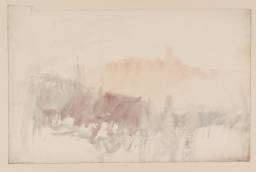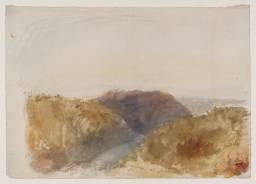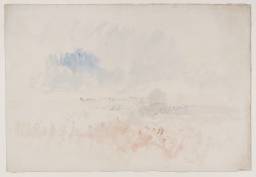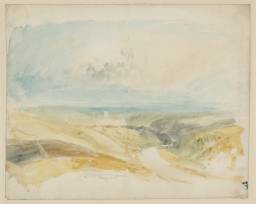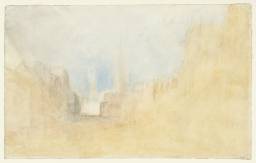Colour Studies Relating to ‘Picturesque Views in England and Wales’ c.1825–39
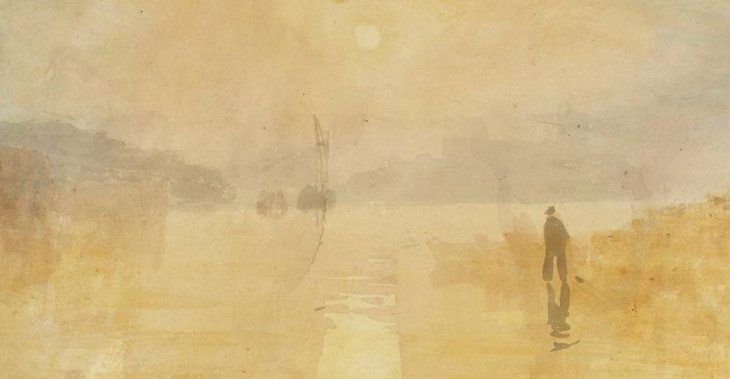
Castle Upnor c.1829-30
From the entry
The loose, atmospheric watercolours catalogued in the present section are, to use the formulation of A.J. Finberg, the Turner Bequest’s first cataloguer, ‘colour beginnings’. They evoke landscape and townscape settings in relation to the major series of Turner’s watercolours engraved as Picturesque View in England and Wales (published 1827–38), which Andrew Wilton has described as ‘the central document in Turner’s art’. These colour studies often relate fundamentally to the highly detailed finished compositions, albeit sometimes at first sight in seemingly rather indirect or tangential ways. In considering England and Wales from their perspective, this is not the occasion for a detailed account of the history and significance of the published series, which has been covered in great detail elsewhere, particularly by Andrew Wilton and Eric Shanes. A hundred finished watercolours were made, of which ninety-six were engraved and issued in ...
D17204, D25123–D25134, D25136, D25141–D25146, D25150, D25151, D25153, D25154, D25156, D25158, D25159, D25161–D25163, D25165, D25166, D25170–D25172, D25174, D25176, D25177, D25179, D25181, D25183–D25185, D25187, D25189, D25192, D25194, D25195, D25198, D25203–D25205, D25207, D25211, D25214, D25215, D25217, D25218, D25220–D25222, D25224–D25229, D25231, D25232, D25240, D25243, D25245, D25246, D25250, D25251, D25256, D25268, D25270, D25274, D25276, D25277, D25280, D25282–D25284, D25286, D25288, D25289, D25293, D25294, D25297, D25298, D25306, D25308, D25310, D25313, D25318, D25350, D25427, D25471, D25473, D25474, D25484, D25485, D25488, D25489, D25509, D25514, D36222, D36292, D36300, D36306, D36314, D36316, D36319, D36323, D36324, D36326, D36327, D40191, D40192, D40262, D40489
Turner Bequest CXCVII N, CCLXIII 1, 2, 3, 4, 5, 6, 7, 8, 9, 10, 11, 12, 14, 19, 20, 21, 22, 23, 24, 28, 29, 31, 32, 34, 36, 37, 39, 40, 41, 43, 44, 48, 49, 50, 52, 54, 55, 57, 59, 61, 62, 63, 65, 67, 70, 72, 73, 76, 81, 82, 83, 85, 89, 92, 93, 95, 96, 98, 99, 100, 102, 103, 104, 105, 106, 107, 109, 110, 118, 121, 123, 124, 128, 129, 134, 146, 148, 152, 154, 155, 158, 160, 161, 162, 164, 166, 167, 171, 172, 175, 176, 184, 186, 188, 191, 196, 228, 304, 348, 350, 351, 361, 362, 365, 366, 385, 390, CCCLXIV 360, CCCLXV 2, 10, 16, 24, 26, 28, 32, 33, 35, 36
Turner Bequest CXCVII N, CCLXIII 1, 2, 3, 4, 5, 6, 7, 8, 9, 10, 11, 12, 14, 19, 20, 21, 22, 23, 24, 28, 29, 31, 32, 34, 36, 37, 39, 40, 41, 43, 44, 48, 49, 50, 52, 54, 55, 57, 59, 61, 62, 63, 65, 67, 70, 72, 73, 76, 81, 82, 83, 85, 89, 92, 93, 95, 96, 98, 99, 100, 102, 103, 104, 105, 106, 107, 109, 110, 118, 121, 123, 124, 128, 129, 134, 146, 148, 152, 154, 155, 158, 160, 161, 162, 164, 166, 167, 171, 172, 175, 176, 184, 186, 188, 191, 196, 228, 304, 348, 350, 351, 361, 362, 365, 366, 385, 390, CCCLXIV 360, CCCLXV 2, 10, 16, 24, 26, 28, 32, 33, 35, 36
References
The loose, atmospheric watercolours catalogued in the present section are, to use the formulation of A.J. Finberg, the Turner Bequest’s first cataloguer, ‘colour beginnings’.1 They evoke landscape and townscape settings in relation to the major series of Turner’s watercolours engraved as Picturesque View in England and Wales (published 1827–38), which Andrew Wilton has described as ‘the central document in Turner’s art’.2
These colour studies often relate fundamentally to the highly detailed finished compositions, albeit sometimes at first sight in seemingly rather indirect or tangential ways. In considering England and Wales from their perspective, this is not the occasion for a detailed account of the history and significance of the published series, which has been covered in great detail elsewhere, particularly by Andrew Wilton and Eric Shanes.3 A hundred finished watercolours were made, of which ninety-six were engraved and issued in approximately triannual four-plate parts.4 They were initially commissioned by Charles Heath, who bought the finished watercolours from Turner, and exhibited them in their own right in 1829, 1831 and 1833. The publishing history is somewhat convoluted, but in effect the prints were not a financial success and the series concluded in 1838, far short of a projected one hundred and twenty designs. By then, Turner had been had been paid thirty guineas for each of ninety-seven watercolours.
These ninety-seven included The Northampton Election, 6 December 1830 of about 1830–1 (Tate T12321),5 which was not engraved, perhaps to avoid political controversy.6 The same may apply to The Burning of the Houses of Parliament of about 1834–5 (Tate D36235; Turner Bequest CCCLXIV 373), although its relative lack of detail may indicate that it is not quite resolved anyway. Merton College, Oxford, of about 1835–8 (Tate D25472; Turner Bequest CCLXIII 349), was completed but not engraved, and may have been made too late to be included; it is the only unequivocally finished topographical work in England and Wales mode to have remained in Turner’s studio and the Turner Bequest. Another finished watercolour, Lichfield, of about 1832 (private collection),7 was not engraved, although its format suggests it was produced for the series (see under Tate D25215; Turner Bequest CCLXIII 93). There is one completed and published England and Wales watercolour in the Tate Collection: Aldborough, Suffolk (i.e. Aldeburgh), made in about 1826 (Tate N05236),8 and engraved in 1827 (Tate impressions: T04521, T04522, T06076). The Northampton, Houses of Parliament, Merton College and Aldeburgh watercolours are considered elsewhere in the present catalogue.
The present colour studies were made either directly in connection with particular identified compositions to establish their overall composition and mood in terms of light and weather effects, as experimental variations on the same subjects, or as what may be studies for unexecuted subjects. A few others, similar in size and technique but with no identifiable topographical subject, are also included here. They are divided into subsections accordingly. Shanes has noted that the finished England and Wales designs are ‘often superimposed over extremely spontaneous underpaintings. A mark of Turner’s lofty conceptual and creative intentions for the project are the unusually large number of watercolour studies and sketches he elaborated in connection with it’.9
The selection of ‘colour beginnings’ in the present section is based very closely on Eric Shanes’s list of works relating to the ‘England and Wales Series, Picturesque Views in’ in his pioneering 1997 Watercolour Explorations catalogue, compiled for a Tate exhibition during his Magnox Electric Turner Scholarship.10 He focused particularly on three extensive Turner Bequest sections established and named by A.J. Finberg (CCLXIII ‘Colour Beginnings’,11 CCCLXIV ‘Miscellaneous: Colour’12 and CCCLXV, also ‘Miscellaneous: Colour’13), in relation to England and Wales and to many other print projects and broader themes. Works from each of these groupings are included here, and Tate D17204 (Turner Bequest CXCVII N), a study of Richmond, Yorkshire, from an earlier ‘Colour Beginnings’14 section, has been added.
Shanes acknowledged identifications made by predecessors, but offered many new ones of his own, with varying degrees of certainty.15 As tabulated below, seven works proposed by Shanes have been excluded here, having been positively identified as different subjects or on the grounds of other commentators’ opinions:
| Tate | Turner Bequest | Shanes 1997 England and Wales: suggested identification | Current Tate title/notes |
| D25135 | CCLXIII 13 | p.95: ‘?Sketch of the Pool of London, c.1828, ... or a view of St Mary Redcliffe, Bristol, from the harbour’ | Angers: ?Study for a ‘Keepsake’ Design (France) |
| D25216 | CCLXIII 94 | p.96: ‘Sketch for a view of Porlock Hill, Somerset, c.1834’ | Rouen from the north (France) |
| D25311 | CCLXIII 189 | p.96: ‘?Sketch for a view of Foreland Point and Lynmouth Bay from Lynton, north Devon ... But see also France and Italy categories’ | Study of a Classical Landscape: ?Lake Maggiore (Ian Warrell suggests a connection with Arona, Lago Maggiore, in a private collection)16 |
| D36027 | CCCLXIV 183 | p.96: ‘?Study related to Beaumaris, Isle of Anglesey, c.1835’ (The Huntington Library, Art Collections, and Botanical Gardens, San Marino, California)17 | The Kapellbrücke at Lucerne, with the Blue and Rose Rigi in the Distance (Switzerland) |
| D36299 | CCCLXV 9 | p.97: ‘?Sketch for a view of Caernarfon Castle, c.1833’ | Lake and Mountains (dated by Robert Upstone to the early 1840s as an ‘Alpine scene’)18 |
| D36312 | CCCLXV 22 | p.97: ‘?Sketch for a view of Caernarfon Castle, c.1833’ | Sky Study (dated by Upstone to about 1845; possibly made on the coast around Margate, Kent)19 |
| D36329 | CCCLXV 38 | p.97: ‘?Study for Richmond Hill and Bridge with a Pic Nic Party, Surrey, c.1829’ (British Museum, London)20 | Palace of La Belle Gabrielle (France) |
It is possible that subsequent research may lead to the precise identification and reallocation of some of the more speculatively titled subjects currently included here as England and Wales subjects. Others are likely to remain unconfirmed, owing to a lack of the topographical pointers which have enabled many otherwise rather generic compositions to be linked convincingly back to preliminary pencil sketches or forwards to finished designs.
Technical notes:
The works in this section are generally characterised by broad watercolour washes on white wove paper. Eric Shanes has discussed the techniques of the ‘colour beginnings’ in some detail.21 In particular he notes that Turner worked on groups of designs at the same time, sometimes within the same sheet of paper and subsequently divided.22 Specific cases are discussed in the individual entries.
See Eric Shanes, ‘Beginnings’ in Evelyn Joll, Martin Butlin and Luke Herrmann (eds.), The Oxford Companion to J.M.W. Turner, Oxford 2001, pp.21–3; among many other accounts, see also Andrew Wilton in Martin Butlin, Wilton and John Gage, Turner 1775–1851, exhibition catalogue, Royal Academy, London 1974, p.26; and Andrew Wilton, J.M.W. Turner: His Life and Work, Fribourg 1979, p.187.
For a concise, up-to-date account, see Shanes 2001, pp.87–9; for the ninety-seven commissioned watercolours see Wilton 1979, pp.391–403 nos.785–881; see also the chapter ‘England and Wales’ in ibid., pp.173–92; Eric Shanes, Turner’s Picturesque Views in England and Wales 1825–1838, London 1979, including an introduction by Wilton; Eric Shanes, ‘New Light on the “England and Wales” Series’, Turner Studies, vol.4, no.1, Summer 1984, pp.52–4; and Eric Shanes, Turner’s England 1810–38, London 1990, pp.13, 162–260, 273–7.
See W[illiam] G[eorge] Rawlinson, The Engraved Work of J.M.W. Turner, R.A., vol.I, London 1908, pp.xlvii–l, xciv–xcvi, 117–69 nos.209–304; see also Luke Herrmann, Turner Prints: The Engraved Work of J.M.W. Turner, Oxford 1990, pp.112–40, 264–5.
See A.J. Finberg, A Complete Inventory of the Drawings of the Turner Bequest, London 1909, vol.II, p.814.
See comments in David Hill, ‘Turner’s “Colour Beginnings” in Britain’, Turner Society News, no.76, August 1997, p.7.
Wilton 1979, p.384 no.730, reproduced; for D25311 see Ian Warrell in Warrell, Blandine Chavanne and Michael Kitson, Turner et le Lorrain, exhibition catalogue, Musée des beaux-arts, Nancy 2002, p.155 no.80, reproduced in colour, p.198.
How to cite
Matthew Imms, ‘Colour Studies Relating to ‘Picturesque Views in England and Wales’ c.1825–39’, March 2013, in David Blayney Brown (ed.), J.M.W. Turner: Sketchbooks, Drawings and Watercolours, Tate Research Publication, December 2013, https://www

